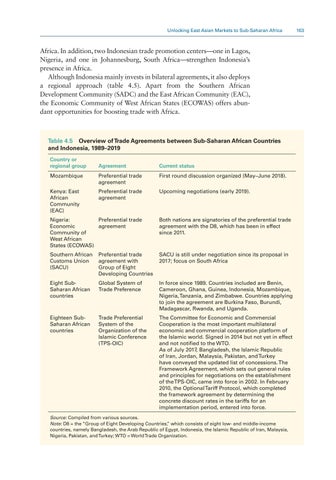Unlocking East Asian Markets to Sub-Saharan Africa 163
Africa. In addition, two Indonesian trade promotion centers—one in Lagos, Nigeria, and one in Johannesburg, South Africa—strengthen Indonesia’s presence in Africa. Although Indonesia mainly invests in bilateral agreements, it also deploys a regional approach (table 4.5). Apart from the Southern African Development Community (SADC) and the East African Community (EAC), the Economic Community of West African States (ECOWAS) offers abundant opportunities for boosting trade with Africa.
Table 4.5 Overview of Trade Agreements between Sub-Saharan African Countries and Indonesia, 1989–2019 Country or regional group
Agreement
Current status
Mozambique
Preferential trade agreement
First round discussion organized (May–June 2018).
Kenya: East African Community (EAC)
Preferential trade agreement
Upcoming negotiations (early 2019).
Nigeria: Preferential trade agreement Economic Community of West African States (ECOWAS)
Both nations are signatories of the preferential trade agreement with the D8, which has been in effect since 2011.
Southern African Customs Union (SACU)
Preferential trade agreement with Group of Eight Developing Countries
SACU is still under negotiation since its proposal in 2017; focus on South Africa
Eight SubSaharan African countries
Global System of Trade Preference
In force since 1989. Countries included are Benin, Cameroon, Ghana, Guinea, Indonesia, Mozambique, Nigeria, Tanzania, and Zimbabwe. Countries applying to join the agreement are Burkina Faso, Burundi, Madagascar, Rwanda, and Uganda.
Eighteen SubSaharan African countries
Trade Preferential System of the Organization of the Islamic Conference (TPS-OIC)
The Committee for Economic and Commercial Cooperation is the most important multilateral economic and commercial cooperation platform of the Islamic world. Signed in 2014 but not yet in effect and not notified to the WTO. As of July 2017, Bangladesh, the Islamic Republic of Iran, Jordan, Malaysia, Pakistan, and Turkey have conveyed the updated list of concessions. The Framework Agreement, which sets out general rules and principles for negotiations on the establishment of the TPS-OIC, came into force in 2002. In February 2010, the Optional Tariff Protocol, which completed the framework agreement by determining the concrete discount rates in the tariffs for an implementation period, entered into force.
Source: Compiled from various sources. Note: D8 = the “Group of Eight Developing Countries,” which consists of eight low- and middle-income countries, namely Bangladesh, the Arab Republic of Egypt, Indonesia, the Islamic Republic of Iran, Malaysia, Nigeria, Pakistan, and Turkey; WTO = World Trade Organization.


